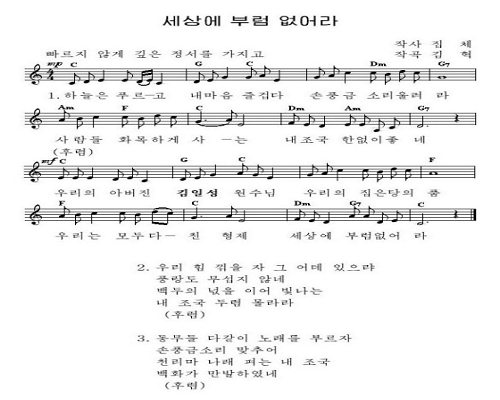It’s time for a closer look inside the pages of the Rodong Sinmun, North Korea’s Party-run newspaper. While primarily serving as a propaganda platform to glorify the Kim regime, it nonetheless provides outside observers with valuable insights into the psychology of North Korea’s leadership. Today we’ll be analyzing an article from the February 27th edition that discusses the song “We Have Nothing to Envy in the World.” The article claims that the song is being played at construction sites along Pyongyang’s Ryomyong Street. So, what kind of song is this?
This is a very well-known North Korean song made in 1961. I still remember the music and the lyrics, even though it’s been a long time since I sang it.
The song starts with the lyrics, “Blue is the sky and happy is my mind.” A little later, it continues, “Our father is Marshall Kim Il Sung/ Our home is the bosom of the party/ We are all brothers and sisters/ We have nothing to envy in the world.”
The song is targeted at young children and tells them how to think about things, and claims that the leader and Worker’s Party make the people happy. There was originally a verse referring to Kim Il Sung as “our father,” but this lyric has been changed over time. First, it was replaced with Kim Jong Il, and now it has been replaced by Kim Jong Un.
The article claiming that the song is being played at construction sites along Ryomyong Street also states that residents who are moving into the newly constructed private homes along the street have “nothing in the world to envy.”
Can you provide a bit more background to help us understand why this song is being used in this context?
It’s likely intended to suggest that Kim Jong Un is building a world in which North Koreans have nothing to envy. There’s a perception that people from the Kim Il Sung era were happier than people are today in North Korea. From my personal experience, the 1960s were the happiest period in my life. The local store had everything you needed.
The publicly-owned stores back then were filled with candy, snacks, fish, and premium goods. I also remember buying and eating great pork ribs on occasion. The authorities are playing this song at the construction sites to remind people of the happier times. It also comes as a suggestion that the country will re-enter prosperity.
According to the article, building construction along Ryomyong Street will be continued with “all-night battles” until Kim Il Sung’s birthday on April 15. We’re approaching the one-year mark from the start of construction, which was announced in March of last year. Is it burdensome for the residents who are mobilized for construction?
It looks like Kim Jong Un has handed down an order to finish the construction of Ryomyong Street by April 15. When there’s a general mobilization, construction continues night and day. This most likely means that Pyongyang residents and residents from other regions have been mobilized to participate in the hard labor needed to develop the area.
North Korean leaders maintain tight control over construction projects and deadlines. For example, construction of the Joson Minsok Park next to the Daeseong Mountain Amusement Park was ordered by Jang Song Thaek. After his execution, the park took on a different appearance. Although Kim Jong Un is no engineering expert, his every word is taken quite literally and carried out to his exact requests.
On February 25, the Rodong Sinmun ran an article titled, “Blooming love for the people at fish farms.” The article notes, “There is a fish farm to mark every important endeavor in Kim Jong Il’s revolutionary life.” Is it true that numerous fish farms were constructed during the Kim Jong Il era?
Korean Central News Agency (KCNA) reported on January 21 that Kim Jong Un had inspected modernization efforts underway at a fish farm in South Hwanghae Province’s Samchon County. It declared that the facility produces over 3,000 tons of catfish on an annual basis and that the factory was turning Kim Jong Il’s noble proclamations into reality.
Talking about fish farms reminds me of when I was living in North Korea. In the year 2000, Kim Jong Il ordered the construction of numerous catfish farm to provide food. At the time, there were factories springing up all over the place, from large factory enterprises to regional-level factories.
Kim Jong Il’s accomplishment of “plentifully feeding fish to the people” is portrayed by state media as an “immortal achievement.” But is it true that the people were able to eat a lot of fish thanks to these factories?
It’s probably true that the intention was to feed the general population. But that’s not what ended up happening. In the big cities like Pyongyang, people eat spicy catfish stew. The fish is quite flavorless, so it’s usually cooked in spicy dishes to compensate. In truth, not many people go to restaurants and order catfish. The claim that everyone ate heartily was simply false.
Kim Jong Un is also quite interested in fish farms. Do you believe that Kim Jong Un’s policy of using fish farms to solve the food shortage problem will be effective?
Of course, it’s a good thing if the fish farms are revitalized. However, I think the main reason for this propaganda is to make it seem like Kim Jong Un is actively trying to address the needs of the people. But I don’t think it will make a big difference in actuality, and he should leave such decisions to experts who understand the magnitude of the problems.


















